Quantum cascade laser-based and Raman spectroscopy vie for position in the growing marketplace for systems that detect chemical and biological threats at a distance.
When the Perseverance rover landed in Mars’ Jezero crater on Feb. 18, 2021, it represented not only a leap in the search for life on the red planet but also in the identification of deadly chemicals on Earth. Mounted to the rover’s robotic arm is a 9-lb, deep-ultraviolet (DUV) Raman and fluorescence spectrometer called SHERLOC, which stands for Scanning Habitable Environments with Raman & Luminescence for Organics & Chemicals.
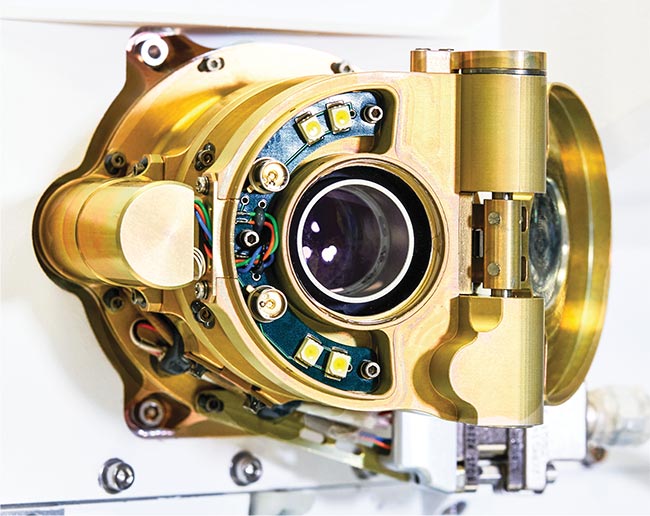
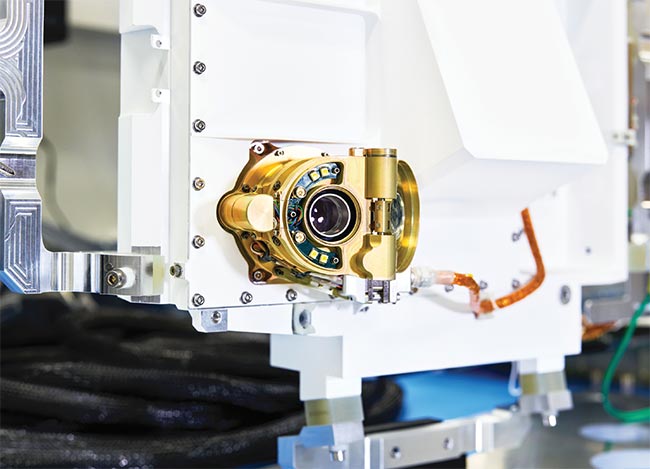
An engineering model of the Mars Perseverance rover’s SHERLOC deep-ultraviolet (DUV) Raman and fluorescence spectrometer. Courtesy of Jet Propulsion Laboratory.
SHERLOC’s neon-copper laser supports simultaneous Raman and fluorescence emission detection through
268.6-nm excitation. One of the instrument’s most recent discoveries came last August with the observation of fluorescence from organics that were co-located with minerals such as olivine and carbonate, suggesting an abiotic formation of organics.
Meanwhile, back on Earth — in Covina, Calif., specifically — Photon Systems, the company behind the Perseverance rover’s spectrometer, is leveraging the same DUV laser technology to arm first responders with a fully self-contained, hand-held, point-and-shoot sensor for detecting trace amounts of chemical, biological, and explosive materials on surfaces up to 5 m away.
The device is just one example of how eye-safe DUV Raman spectrometers are entering the market for distant threat detection — a market in which quantum cascade lasers (QCLs) operating in the MIR/terahertz range have long dominated by detecting chemical and biological threats from tens to hundreds of meters away, though usually with less portable systems. These two technologies are now competing for position.
“There are currently products using QCL and standoff Raman competing in the chemical warfare agent and toxic industrial chemical space,” said Christina Baxter, a partner in Hazard3, an emergency response consulting firm. “Unfortunately, most of these products are focusing towards ‘clouds’ of material when a vast majority of chemicals are actually heavier than air and will be ‘hugging the ground.’”
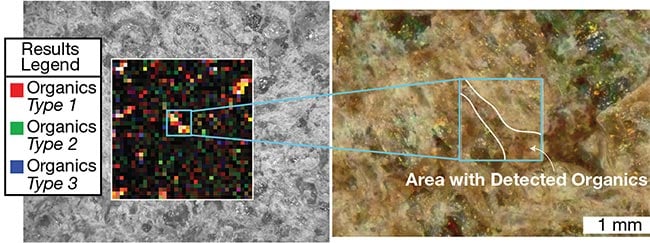
SHERLOC’s view of the organics within Mars’ Garde abrasion patch. Courtesy of Jet Propulsion Laboratory.
Companies such as Photon Systems, Pendar, and Alakai Defense Systems are developing hand-held proximal and standoff Raman analyzers, while players such as Block Engineering are preparing hand-held proximal QCL detectors.
QCLs are preferred for probing possible explosives, especially when probing materials in bulk, because Raman can be an ignition source, said Peter Loges, Block Engineering’s vice president of product management. “I think that QCL and Raman [have] different performance behaviors that differentiate the systems and applications for which they are best suited,” he said. “In the short term this will be competitive, but over time the optimal solution for each application will be determined and each will find their own application niches.”
Standoff detection
Photon Systems said its hand-held analyzer instrument is the first fully integrated, real-time DUV Raman and fluorescence analyzer. Weighing 12 lbs, the point-and-shoot spectrometer is equipped with an autofocus telescope that can detect trace chemical and biological agents from a range of 0.6 to 5 m. The device’s UV Raman technology detects amino acids, alcohols, and aliphatics in the 250- to 4000-cm−1 spectral range while its UV fluorescence component detects organics, microbes, proteins, peptides, and pollens in the 270- to 320-nm range.
Standoff detection is generally understood to mean the ability to cover distances in the centimeters-to-meters range. However, the North Atlantic Treaty Organization (NATO) is more precise in its definitions. It characterizes detection between 10 cm and 200 m as “proximal” and detection at distances exceeding 200 m as “standoff.” NATO further labels detection at distances under 10 cm as “point,” according to Augustus W. Fountain III, a University of South Carolina chemistry professor and former senior research scientist for the Edgewood Chemical Biological Center at the Aberdeen Proving Ground in Maryland.
Over the past five-plus years, the U.S. Department of Defense (DOD) and the Department of Homeland Security (DHS), as well as other government agencies, have been focused on detecting trace residues on surfaces rather than targeting aerosol threats, Fountain said. “With respect to the detection of trace chemical hazards, the efforts to further develop both QCL and Raman technologies tend to be within the proximal range, tens of meters, and not what we would classically consider ‘standoff.’”
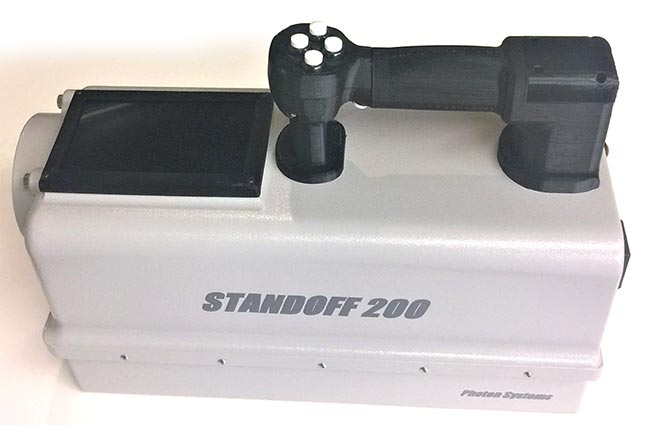
Photon Systems leveraged the DUV laser technology that powers SHERLOC to develop a fully self-contained, hand-held, point-and-shoot sensor for detecting trace amounts of chemical, biological, and explosive materials on surfaces up to 5 m away. Courtesy of Photon Systems.
With sub-250-nm excitation, the DUV laser powering Photon Systems’ hand-held spectrometer is unable to penetrate the retina and is no more hazardous than sunlight, qualifying it as both eye- and skin-safe. The development of this type
of DUV fluorescence/Raman instrument, as well as the SHERLOC, dates back more than two decades to Photon Systems’ collaboration with scientists
at NASA’s Jet Propulsion Laboratory (JPL). While the DOD funded the development of the hand-held instrument, the
work built on NASA’s efforts that predated Photon Systems’ proposal for the SHERLOC.
“As [the work] has continued, we have been able to incorporate a number of the lessons learned from SHERLOC,” said William F. Hug, Photon Systems’ chairman and CEO. “Perhaps the most important advancement was on the laser.”
The collaboration between Photon Systems and JPL on the SHERLOC laser led to a system that exceeded both the required laser energy output and the instrument’s reliability standards when exposed to harsh conditions, such as the very large variations in temperature, and the vibrations and shock during launch, landing, and operations on Mars’ surface. “These efforts led to better optimizations that make the Photon Systems source the most ruggedized and tested deep-UV laser,” Hug said.
Next steps for standoff detection
In 2019, Pendar, which is located in Cambridge, Mass., introduced what it said is the first Raman system in the hand-held market that utilizes an eye-safe laser. The instrument uses differential Raman spectroscopy and leverages algorithms to apply chemometrics-based analytics. Last year, DHS and the U.S. Army Combat Capabilities Development Command (DEVCOM) Chemical Biological Center started a pilot program using Pendar’s technology to expand DHS’s threat detection library.
“Standoff Raman spectroscopic techniques have advanced in recent years with regard to their sensitivity, the compactness and quality of the instrumentation, and the ability to overcome fluorescence interference,” said Erik Emmons, a research chemist at the DEVCOM Chemical Biological Center. “Use of longer wavelengths with less fluorescence, as well as other fluorescence mitigation techniques, have been made possible with continued advancements in compact Raman spectrometer technology. The sensitivity of these instruments can be impressive.”
Emmons said the use of Raman sensors in conjunction with unmanned ground vehicles (UGVs) and unmanned aerial vehicles (UAVs) reduces the need for the sensor system itself to have a long standoff capability. However, the need to detect hazardous threats from a distance remains great for first responders. The Massachusetts Department of Fire Services’ Hazardous Materials Emergency Response Division recently received a grant to purchase Pendar’s hand-held Raman spectrometer. The division’s
director, David DiGregorio, said his hazmat teams regularly use Raman technology to see through transparent containers, though this still requires contact
with the product or its container.
“The physical danger from the laser to the user’s eyes and the risk of potentially igniting dark materials and/or energetics
has been significantly lessened with newer Raman applications,” he said.
In the parlance of Raman spectroscopy,
dark materials are substances that absorb more light and therefore require an amount of laser that can bring them to their ignition point. In the past, even small, dark particles could be ignited by conventional Raman technology. Delayed timers helped in these circumstances, but the risk remained for potential fire hazards, as well as for the continued functionality of Raman instruments. “Newer technologies have all but removed these factors,” DiGregorio said.
Alakai Defense Systems in Largo,
Fla., has also developed an eye-safe
UV Raman hand-held analyzer with a
detection distance of 5 m. Its 5.5-lb
(including battery) SAFR (situational awareness for first responders) instrument can be applied to the detection of chemical warfare agents, explosives, heroin, cocaine, and meth manufacturing byproducts.
QCLs
In 2010, Block Engineering was named a finalist in that year’s SPIE Prism Awards for its development of a widely tunable QCL mid-IR spectrometer with a detection distance of up to 2 ft. Block is aiming to update the technology as a hand-held instrument for the field inspection of a wide range of dangerous materials, according to Loges.
Block has also received government funding to develop a 2D version of its instrument for trace detection of hazardous and explosive substances on vehicles attempting to enter soft targets such as stadiums and parking garages. This new device, due out next year, will offer a
detection distance of up to 2 m, with a trace surface sensitivity up to 10 µg/cm2.
Some hazardous materials are not easily detected by either QCL-based or Raman spectroscopy for various reasons.
Chlorine and volatile chemical agents — such as sarin, for example — have a limited signature, whereas QCLs emit in the MIR and the most adjacent spectral bands in the long-wave IR range. Active IR systems using QCLs could improve these detection limits, but neither active nor passive solutions will help to sense chlorine gas, which is not detectable in the IR, the University of South Carolina’s Fountain said.
Some nonvolatile agents also pose challenges for QCL-based and Raman spectroscopy because the agents are so lethal even in trace amounts. Exposure to the VX nerve agent, any of the Novichok agents, and even the synthetic opioid carfentanil can be deadly, even in tiny doses equivalent to the area of Lincoln’s eye on a U.S. penny, Fountain said. Yet, detection of such trace amounts, he said, is why military and law enforcement are looking to QCL and Raman technologies for solutions.
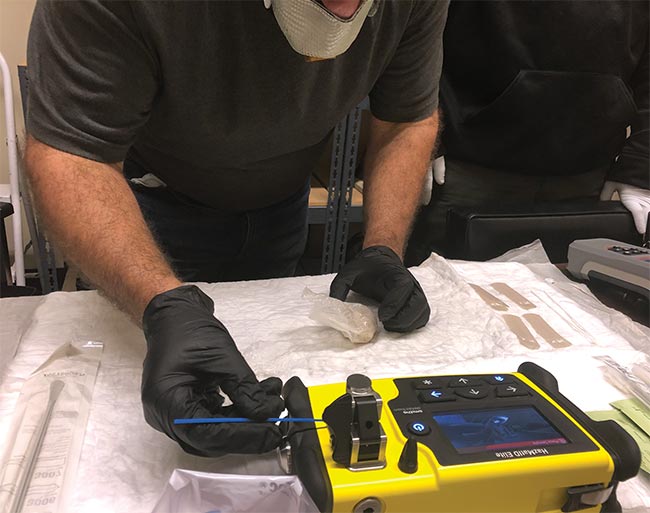
The ability to detect fourth-generation agents, particularly pharmaceutical-based agents, at a distance can enhance the safety of law enforcement officers and first responders. Courtesy of Massachusetts Department of Fire Services.
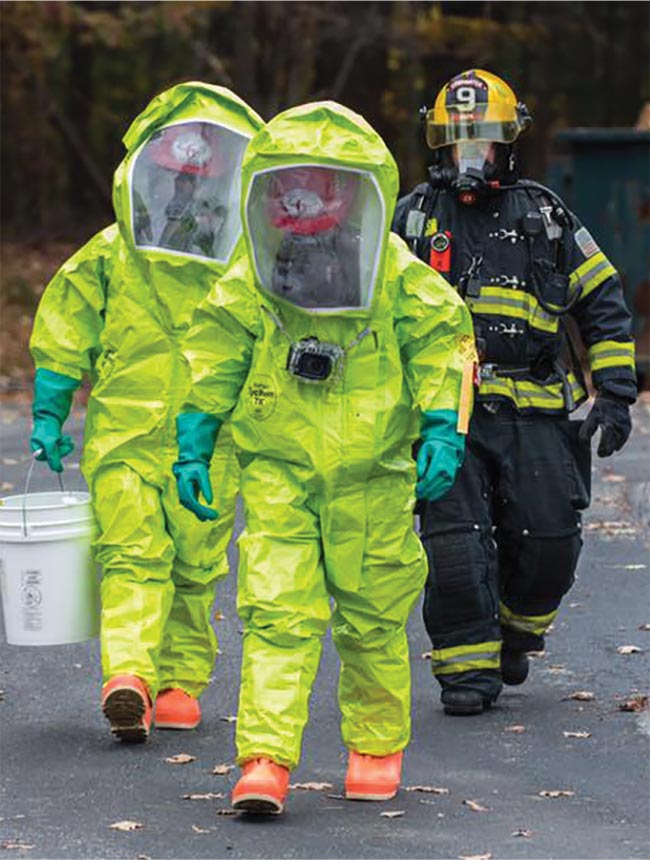
Most hazmat teams already have Raman technology in their arsenals, but current solutions may not be able to detect threats at a distance. Courtesy of Massachusetts Department of Fire Services.
The DEVCOM Chemical Biological Center’s Emmons said the solution may require better techniques to narrow down areas on a target that are more worthwhile for scanning. “Different imaging techniques that can identify spots of interest can increase the probability of finding threats faster,” he said. These techniques must not add too much to the size, weight, power, and cost requirements of the
system, he added.
The inverse square law also poses a challenge for the miniaturization of spectrometers for threat detection. “The greater the standoff distance, the more light-gathering power you need to collect a measurable signal,” Fountain said.
“That generally means bigger optics, which goes against the trend to miniaturize the instruments. I think that will
limit any of these technologies to proximal ranges from near contact to tens of meters.”